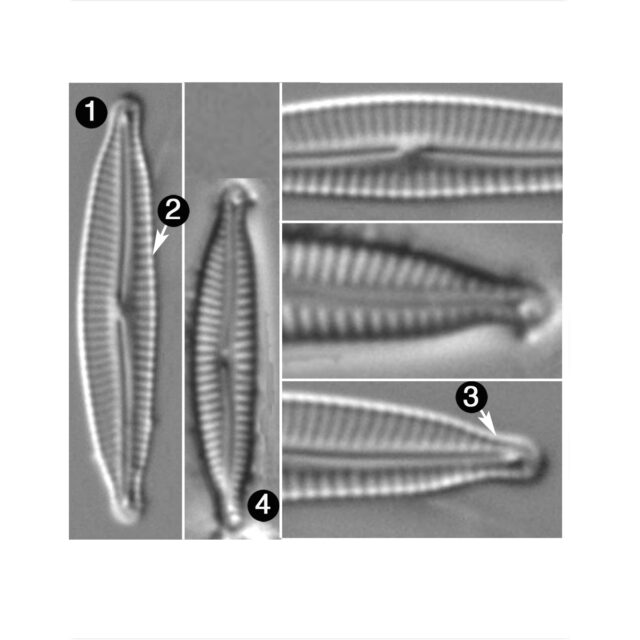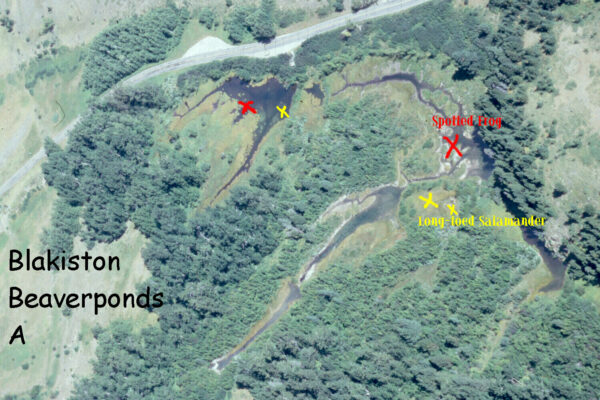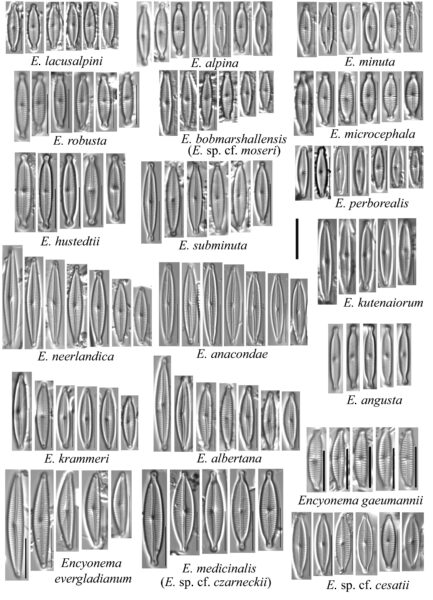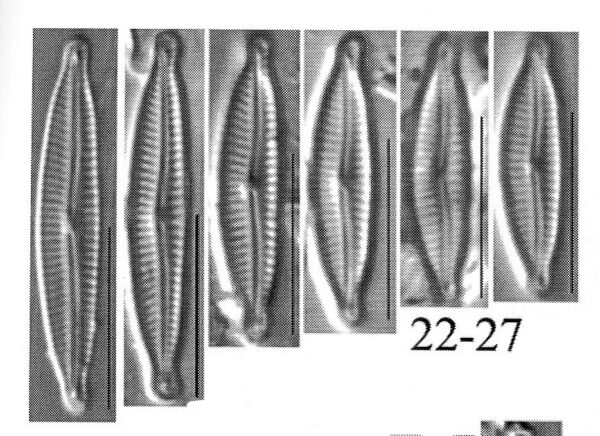Encyonopsis albertana
-
Category
-
Length Range14.3-22.5 µm
-
Width Range3.1-4.1 µm
-
Striae in 10 µm20-24
-
ContributorLoren Bahls - May 2013
-
ReviewerMark Edlund - Aug 2013
Identification
Description
Valves are narrowly lanceolate and moderately dorsiventral with rostrate apices slightly deflected ventrally. The dorsal margin is arched and the ventral margin is straight or weakly convex. The axial area is narrow, located about 1/3 the distance from the ventral margin to the dorsal margin. The central area is very small and continuous with the axial area. Raphe branches are filiform and bowed, concave to the dorsal margin. Proximal raphe ends are unexpanded and deflected dorsally. Distal raphe fissures are hooked toward the ventral margin. Striae are radiate.
Autecology
Encyonopsis albertana is widely distributed and locally abundant in lakes, beaver ponds, and spring creeks in southwestern Alberta and northwestern Montana. These waters are alkaline (pH range 7.2-9.2) with moderate levels of dissolved solids (specific conductance range 141-255 μS/cm).
Encyonopsis albertana is one of many small-celled Encyonopsis and Encyonema species in the Northern Rockies (see plate below). Some of these may be ecomorphs of established species. All of these may be found in Krammer (1997) and Bahls (2013).
-
Size Range, µm3
-
Motility
-
Attachment
-
Habitat
-
Colony
-
Waterbody
-
Distribution
- Learn more about this
Original Description
Valves narrowly lanceolate, moderately dorsiventral, dorsal margin arched, ventral margin straight or weakly convex. Valve length 14.3–22.5 μm; valve width 3.1–4.1 μm. Apices rostrate, deflected ventrally. Axial area narrow, about 1/3 the distance from the ventral margin to the dorsal margin. Central area very small, continuous with the axial area. Raphe branches filiform and bowed, concave to the dorsal margin. Proximal raphe ends unexpanded, deflected dorsally; distal raphe fissures hooked toward the ventral margin. Striae radiate, 20–24 in 10 μm.
-
AuthorBahls 2013
-
Length Range14.3-22.5 µm
-
Width3.1-4.1 µm
-
Striae in 10µm20-24
Citations & Links
Citations
Links
-
Index Nominum Algarum
Cite This Page
Bahls, L. (2013). Encyonopsis albertana. In Diatoms of North America. Retrieved April 18, 2024, from https://diatoms.org/species/encyonopsis_albertana
Responses
The 15 response plots show an environmental variable (x axis) against the relative abundance (y axis) of Encyonopsis albertana from all the stream reaches where it was present. Note that the relative abundance scale is the same on each plot. Explanation of each environmental variable and units are as follows:
ELEVATION = stream reach elevation (meters)
STRAHLER = distribution plot of the Strahler Stream Order
SLOPE = stream reach gradient (degrees)
W1_HALL = an index that is a measure of streamside (riparian) human activity that ranges from 0 - 10, with a value of 0 indicating of minimal disturbance to a value of 10 indicating severe disturbance.
PHSTVL = pH measured in a sealed syringe sample (pH units)
log_COND = log concentration of specific conductivity (µS/cm)
log_PTL = log concentration of total phosphorus (µg/L)
log_NO3 = log concentration of nitrate (µeq/L)
log_DOC = log concentration of dissolved organic carbon (mg/L)
log_SIO2 = log concentration of silicon (mg/L)
log_NA = log concentration of sodium (µeq/L)
log_HCO3 = log concentration of the bicarbonate ion (µeq/L)
EMBED = percent of the stream substrate that is embedded by sand and fine sediment
log_TURBIDITY = log of turbidity, a measure of cloudiness of water, in nephelometric turbidity units (NTU).
DISTOT = an index of total human disturbance in the watershed that ranges from 1 - 100, with a value of 0 indicating of minimal disturbance to a value of 100 indicating severe disturbance.

Encyonopsis albertana
- Valves narrowly lanceolate
- Ventral margin flat or weakly arched
- Apices rostrate
- Striae 20-24 in 10 μm
- Valves mostly < 20 µm long
Encyonopsis albertana has narrowly lanceolate and moderately dorsiventral valves that are generally less than 20 µm long and with rostrate apices. The ventral valve margin is flat or weakly arched. Striae number 20-24 in 10 μm.
 Diatoms of North America
Diatoms of North America









